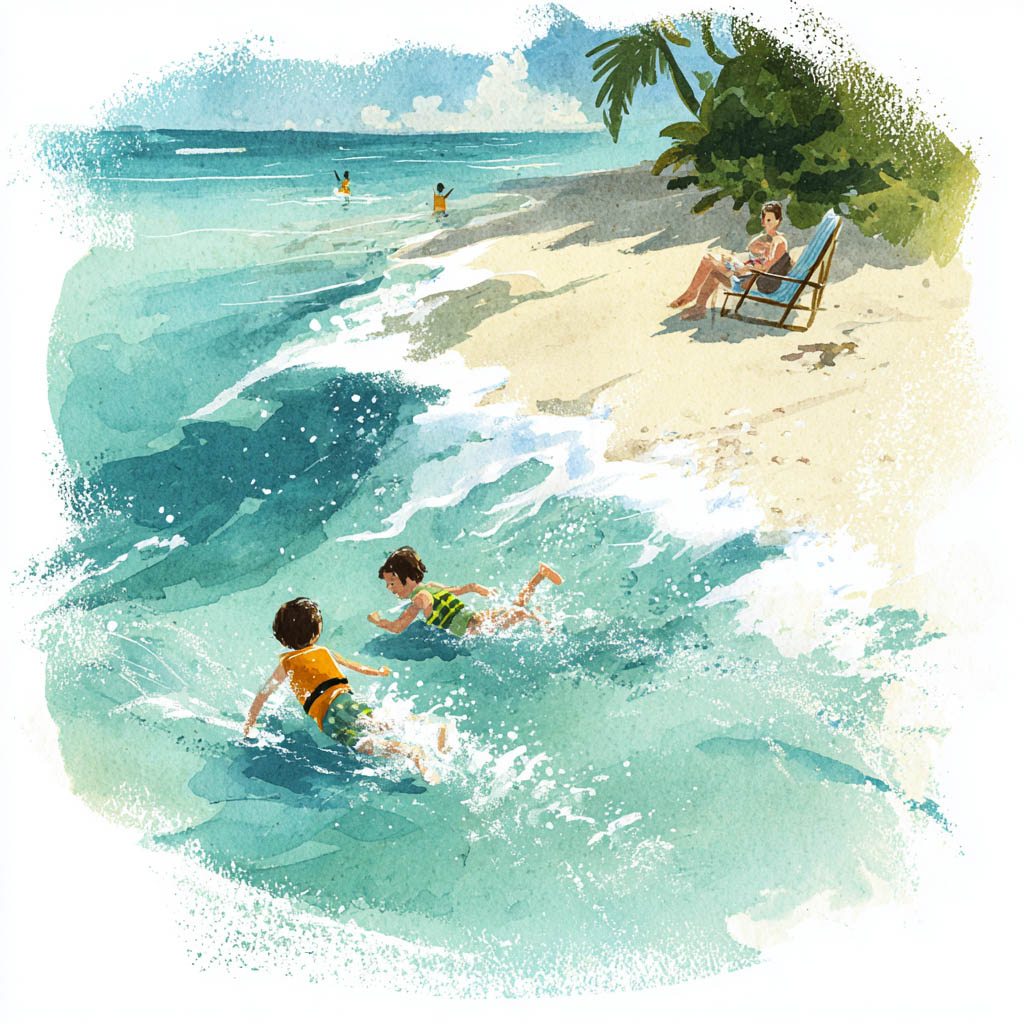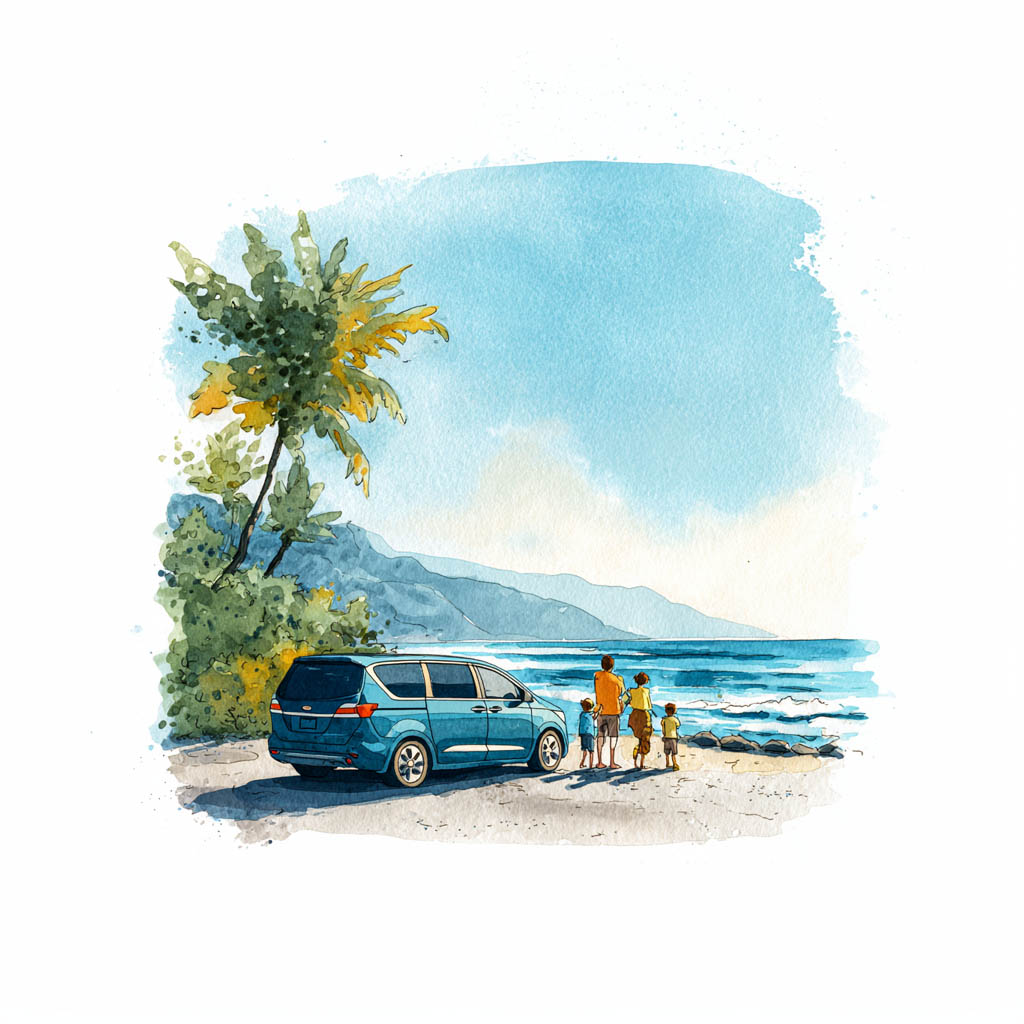בטיחות מים בעת נסיעה עם ילדים להוואי: מה כל הורה צריך לדעת
המים של הוואי יפים - אבל הם גם דורשים כבוד, במיוחד כשנוסעים עם ילדים. מלגונות רגועות ועד קווי חוף דרמטיים, האוקיינוס והנחלים יכולים להיות בלתי צפויים. הנה כל מה שהורים צריכים לדעת כדי לשמור על בטיחות הקייקי (הילדים) שלהם בזמן שהם נהנים מגן עדן.

מדוע בטיחות המים חשובה בהוואי
עם האוקיינוס החם, בריכות הגאות הנסתרות והמפלים המדורגים שלה, הוואי היא יעד חלומי למשפחות - אך היא מציגה גם סיכונים טבעיים שיכולים להפתיע את המבקרים הראשונים. נקיטת כמה אמצעי זהירות פשוטים יכולה לעשות את כל ההבדל בשמירה על בטיחות ילדיכם תוך כדי ליהנות מחוויות המים המדהימות של האיים.
1. בחר חופים בטוחים וידידותיים למשפחות
ראה במפות גוגל
לא כל החופים בהוואי ידידותיים לילדים. לחוויה הבטוחה ביותר, חפש:
- חופים שמורים על הצלה עם אזורי שחייה מסומנים בבירור
- מפרצים מוגנים או לגונות עם מעט או ללא גלישה
- מדרונות עדינים ותחתית חולית
החופים הטובים ביותר לילדים באואהו:
🏖️ לגונות קו אולינה - רגוע, סגור, נהדר לפעוטות
🏖️ פארק חוף אלה מואנה - מוגן על שף ומרווח
🏖️ חוף וואיקיקי (ליד פסל הדוכס) - גלים עדינים עם מצילים
🏖️ חוף קאילואה — טוב בימים רגועים עם חול רך ושירותים סמוכים
2. הבנת סכנות האוקיאנוס
ראה במפות גוגל
אפילו מים רגועים למראה יכולים להסתיר סכנות חמורות. למדו על:זרמי ריפ: זרמים חזקים שיכולים למשוך שחיינים ליםחופשות חוף: גלים עוצמתיים שנפרצים ישירות לחוף - מסוכנים לילדיםמדוזות קופסה: אלה מופיעים 8-10 ימים לאחר ירח מלא - בדוק דוחות גלישה מקומיים או בטיחות חוף הוואי לפני היציאה
3. התכונן לבטיחות
ראה במפות גוגל
תביא אפודי הצלה שאושרו על ידי משמר החופים האמריקאי עבור אנשים שאינם שחיינים או שייטיםהימנע ממצופים מתנפחיםהם יכולים לתת תחושה כוזבת של ביטחוןלבשו נעלי שונית כדי להגן על כפות רגליים קטנות מפני סלע לבה חד או אלמוגים קרם הגנה בטוח לשריף, שומרי פריחה, וכובעים רחבים שוליים
4. הימנע ממסכות שנורקלינג פנים מלאות
ראה במפות גוגל
מסכות שנורקלינג עם פנים מלאות עשויות להיראות כאופציה קלה למתחילים, אך הן נושאות סיכונים בריאותיים חמורים. מסכות אלה יכולות מלכוד פחמן דו חמצני (CO₂), במיוחד עם שימוש ממושך, מה שמוביל לתסמינים כמו סחרחורת, בלבול, קוצר נשימה, או אפילו אובדן הכרה. כמה טביעות טרגיות בהוואי ויעדים טרופיים אחרים נקשרו לציוד מסוג זה. אנו ממליצים בחום להשתמש ערכות מסכות ושנורקל מסורתיות לילדים ומתחילים. הם מאפשרים זרימת אוויר טובה יותר וניתן להסיר אותם במהירות במקרה חירום. בדוק תמיד ציוד שנורקל באזור רדוד ורגוע לפני הכניסה למים עמוקים יותר - לעולם אל תשנרקל לבד או ללא השגחת מבוגר.
5. פיקוח באופן קבוע ובאופן הדוק
ראה במפות גוגל
הקצה תמיד "צופה במים"מבוגר אחראי שצופה בילדים בכל הזמןשמור על ילדים צעירים בהישג יד, אפילו במים רדודים אל תסמוך על מצילים או תניח שמישהו אחר צופה ⏱️ טביעה יכולה להתרחש בשקט תוך פחות מ -30 שניות - פיקוח מתמיד הוא המפתח.
6. היזהר עם מפלים ונחלים
ראה במפות גוגל
אזורי המים המתוקים של הוואי יכולים להיות יפים אך מסוכנים: לעולם אל תקפוץ או לצלול למפלים או לנחלים - עומקים וסלעים אינם ניתנים לחיזוי צפו בשיטפונות הבזקים, במיוחד לאחר הגשם האחרון - גם אם יש שמש במקום שבו אתה נמצא סלעים רטובים מחליקים - נפילות הן פגיעה שכיחה באזורים אלה. סע לשבילים ייעודיים ולאזורים בטוחים ורדודים אם חוקרים עם ילדים.
7. היזהרו מבריכות גאות וסלעי חוף
ראה במפות גוגל
בריכות גאות וקווי חוף סלעיים יכולים להיראות כמו מקומות מהנים לחקור, אך הם נושאים סיכונים חמורים:גלי נעלי ספורט יכול להתרסק באופן בלתי צפוי ולטאטא אנשים מסלעים לעתים קרובות חלקלק וחד, הגדלת הסיכון לנפילות ופציעותלעולם אל תפנה עורף לאוקיינוס, אפילו במהלך גלישה נמוכה הימנע מטפס על צוקים או לצאת ליד חורים כמו הלונה-זה מסוכן מאוד ואסור להיצמד לאזורים רגועים בימים עם גלישה נמוכה ותמיד בדוק את התנאים קודם.
8. למד בטיחות בסיסית לקיקי שלך
ראה במפות גוגל
הפוך את בטיחות המים למהנה ובלתי נשכחת על ידי לימוד ילדים כללים פשוטים:אם יש ספק, אל תצא"— המתן לתנאים רגועים ומצילים"רגליים ראשונות, אף פעם לא ראש ראשון"- אין צלילה במים לא ידועים"תראה, אל תיגע"- לכבד את החיים הימיים ואת שוניות האלמוגים





